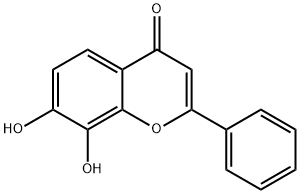CHEMICAL AND PHYSICAL PROPERTIES
| Physical Description | Pale yellow powder; Bland aroma |
|---|---|
| Solubility | Very slightly soluble |
| Collision Cross Section | 152 Ų [M+H]+ [CCS Type: TW, Method: calibrated with polyalanine and drug standards] |
SAFETY INFORMATION
| Signal word | Warning |
|---|---|
| Pictogram(s) |
 Exclamation Mark Irritant GHS07 |
| GHS Hazard Statements |
H315:Skin corrosion/irritation H319:Serious eye damage/eye irritation H335:Specific target organ toxicity, single exposure;Respiratory tract irritation |
| Precautionary Statement Codes |
P261:Avoid breathing dust/fume/gas/mist/vapours/spray. P305+P351+P338:IF IN EYES: Rinse cautiously with water for several minutes. Remove contact lenses, if present and easy to do. Continuerinsing. |
COMPUTED DESCRIPTORS
| Molecular Weight | 254.24 g/mol |
|---|---|
| XLogP3 | 3.3 |
| Hydrogen Bond Donor Count | 2 |
| Hydrogen Bond Acceptor Count | 4 |
| Rotatable Bond Count | 1 |
| Exact Mass | 254.05790880 g/mol |
| Monoisotopic Mass | 254.05790880 g/mol |
| Topological Polar Surface Area | 66.8 Ų |
| Heavy Atom Count | 19 |
| Formal Charge | 0 |
| Complexity | 384 |
| Isotope Atom Count | 0 |
| Defined Atom Stereocenter Count | 0 |
| Undefined Atom Stereocenter Count | 0 |
| Defined Bond Stereocenter Count | 0 |
| Undefined Bond Stereocenter Count | 0 |
| Covalently-Bonded Unit Count | 1 |
| Compound Is Canonicalized | Yes |
PRODUCT INTRODUCTION
description
7,8-dihydroxyflavone is a dihydroxyflavone that is flavone substituted by hydroxy groups at positions 7 and 8. A dihydroxyflavone that is flavone substituted by hydroxy groups at positions 7 and 8. A naturally occurring flavonoid produced by several plants, including the weed Tridax procumbens (coalbuttons or tridax daisy) and the tree Godmania aesculifolia, In animal models, it has shown efficacy against several diseases of the nervous system, including Alzheimer's, Parkinson's, and Huntington's. It has a role as a plant metabolite, a tropomyosin-related kinase B receptor agonist, an antidepressant, an antioxidant and an antineoplastic agent.
